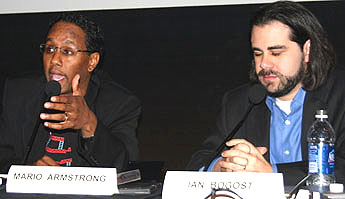| Games and Civic Engagement | ||||
|
A generation of scholars, critics and political leaders has denounced videogames as at best a distraction and at worst a negative influence on society. Yet for a growing generation of activists and researchers, games may also represent a resource for engaging young people with the political process and heightening their awareness of social issues. In what ways do young people use the online societies constructed in multiplayer games to rehearse and refine skills at citizenship? Can we imagine games as a medium that encourages public awareness and citizenship? And what might it mean to empower young people to create their own games to reflect their perceptions of the world around them? This is the second in a continuing series from the new MIT Center for Future Civic Media. Mario Armstrong is a technology correspondent for National Public Radio (for Morning Edition and News and Notes) and hosts talk shows about technology and culture on XM radio and public radio stations WYPR and WEAA in the Baltimore area. Ian Bogost is an assistant professor in the School of Literature, Communication, and Culture at Georgia Tech and co-founder of Persuasive Games. He is the author of Persuasive Games: The Expressive Power of Videogames. Co-sponsors: MIT Comparative Media Studies and the MIT Media Lab. A podcast of Games and Civic Engagement is now available from Comparative Media Studies. A webcast of Games and Civic Engagement is now available from MIT World. By Greg Peverill-Conti
“That is the connection I see between video games and civic engagement,” Bogost said. Eric Klopfer asked about the tension or potential contradiction between games as entertainment and games as agents of awareness, education, moral and civic commitment. “First of all, I don’t think games have to be fun,” Bogost responded. He also didn't think that there was any single right or wrong way for games to be used as instructional tools; video games offer a spectrum of uses and experiences. Bogost said he becomes suspicious when people claim there is only a single approach to using games as an instructional platform.
The media plays a role in the broader discussion, he continued. Saying that “if it bleeds, it leads,” he made the point that the media don’t want to talk about a game that portrays non-violent protest; they want to talk about Grand Theft Auto and the damage it is doing to our children. Bogost picked up on Armstrong’s comment about the intersection of games and politics, saying there are two ways to examine the issue: One is to ask how can games about political issues inform people? And the other is to look at how those in the policy arena use video games rhetorically. He called video games “low hanging fruit” for politicians trying to position themselves as centrists. To appear centrist, many politicians attack and demonize the game industry, its products and the players, he said. What’s surprising is how people in the game industry seem willing to accept the terms of the debate set by the politicians and spend their time trying to defend games and creating groups to lobby for games and players. This approach, according to Bogost, is totally “wrong headed not in its spirit but in its strategy.” It's time for a new frame of reference: games as media. Klopfer pointed out that much of the discussion around games is about games as media for kids. He wanted to know who the audience is for games as civic engagement, and should kids be the prime video game audience? “The short answer is no,” Bogost said, using the question to remind us of how inadequate our cultural memory concerning gaming actually is. When video games first began appearing in the 1970s, they targeted adults. They were more akin to darts or pinball – games played in a tavern. From the bar they made their way into the home. The arcade culture of the early 1980s – with games like Death Race (1976), which allowed players to run over people – generated complaints against violence similar to those heard today. Death Race, he said, was eventually pulled form the market. He went on to describe the long and complicated relationship between the game and toy industries. Bogost blames Nintendo for much of the confusion between games and toys, saying that once games moved into the home the company recognized the potential of the youth market and developed a system of censorship to transform gaming from a media for adults into one for children. This was an important and fundamental change. The question isn't really about different audiences for games as entertainment or civic engagement, it's more important to understand what kinds of games will be useful to different people in different contexts. If we think back 30 years we see a medium that is solely for adults, but we forget that, he repeated. Armstrong took a more literal approach to the question, pointing out that according to the game industry the average age of gamers is 33. And while understanding how games engage children is crucial, he said one of his initiatives is to encourage groups of older, influential people – teachers, activists, church leaders, leaders of non-profits, congressional staffers – to play video games. “That’s the audience I focus on,” he said. Armstrong suggested that a Congressional LAN (local area network) party – that is, a gathering of congress people and their staffs who create a network of computers in order to play video games – would be a great way to start the education process. Bogost agreed that it's important for people in authority to become gamers so they know what younger people encounter when playing video games and they can be there to help children work through issues they face when gaming. He described playing the game Animal Crossing with his 5-year-old son. The game starts with the player running away from home to live in Animal Crossing, moving into a shack, getting a mortgage and paying for it by working for a raccoon selling fish. Saying he has logged hundreds of hours on the game himself, he described how his son came to him with a problem: He had no more room to get around in his shack. His son needed a bigger house but couldn't get one because he'd spent all of his money on things for his small one. Bogost said this presented him with an opportunity to discuss long-term debt with his son who was “horrified” by his explanation of compound interest.
Klopfer next turned to the ways people play different kinds of games. He mentioned more open-ended games that allow players to make choices for which there may or may not be consequences. Citing games such as Grand Theft Auto, known for their violent content, he wondered if games should allow players to make bad choices, and if by doing so they were reinforcing bad behavior. How open ended should these games be? Bogost responded by saying Klopfer’s question engaged two important elements. The first is model building, which determines how things work within a particular game; and the second is role assumption, which determines how a player acts within the constraints of the model. This relationship between model and role is interesting, he said, because it allows people to experience a point of view that isn't their own while operating in a world of rules not of their making. Comparing games that allow players to construct their own worlds, he suggested that having to function in an alien environment through another’s perspective is a more valuable experience. Klopfer next asked how games should be evaluated as educational tools. Armstrong said he was not an academic but at the Urban Video Game Academy they simply watch how kids played with and learned with games. He also found it interesting to watch children who didn't want to be part of the program slowly becoming engaged. His anecdotal experience is that kids soak up content through the medium of games and want to do more with it. Bogost took a different tack, saying he is interested in observing people after they have played and how they are framing the topics presented in a game. He thinks it is more important to watch the impact of games on discourse rather than using quantitative analysis to determine their effectiveness as educational tools. Discussion QUESTION: I am a gamer. As games move from their technological adolescence and become more of an art form, how will this impact the next generation of gamers? BOGOST: Your question is very big and any answer would be speculative, but what I have chosen to do is completely ignore and deny the idea of the gamer. There are not gamers. There are people who play games sometimes, but not gamers. The quicker we stop using that frame to talk about this medium the better off we’ll be. ARMSTRONG: Look at the Wii. Nintendo thinks of people as players not as gamers. On your question, I believe things will become more graphically intense with the introduction of high definition, and with Web 2.0 people will want to collaborate and participate. People want these things to happen but we need to follow this to see where it leads. QUESTION: I am interested in one specific use of games: Adults helping kids navigate bureaucratic systems such as the college application game. How can games help kids be strategic in complex systems without killing their ability to question the system? ARMSTRONG: In my research we didn't look at how games could be used to navigate complex systems, only at how these systems were represented by games. BOGOST: I suggest people read McKenzie Wark’s Gamer Theory. In some ways, games show us how the world has become a game itself. When we frame real-world processes as games we have the ability to show the arbitrariness of the process – or its connection to historical or cultural issues. QUESTION: When you are building a game model, how can you make one that helps encourage reflection and critical thinking? BOGOST: Most of the time, model building is a question of efficiency – how do you get the player to do the next thing? If game design was done just with human-computer interface in mind, they'd all have one button: “Push here to win.” This is the challenge of design, though, to balance structured and open-ended games in a way that will engage people. QUESTION: How do we compare games to other civic media in the political process? ARMSTRONG: We wanted to diversify the game industry, and wondered what are we missing without the participation of the minority community? This industry is mostly white men. How does this impact the development of games? Look at The Sims. If you look at the creative team behind The Sims you will see a great deal of diversity. In terms of civic engagement, kids need to feel that they have a voice. Given the opportunity, kids in the Urban Game Academy came up with games that dealt with unexpected issues – how to impact poverty; how to clean up trash; do we buy food or electricity? They internalized their lives and put it into a model for them to explore and try to master. Kids want to talk about the issues that are affecting them and games can provide the platform for this to happen. QUESTION: How will games increase civic participation? BOGOST: It might be reasonable to look at voter turnout as a measure of engagement. The challenge is that the process of voting is decoupled from people's everyday lives. I would like to think that the political games in which I have been involved have had an impact on civic behavior and I hope that as more people begin exploring these issues through games they will begin making greater demands of themselves and the systems and people around them. ARMSTRONG: In Baltimore, I helped create a system to get more youth engaged with the city's political structure. It wasn't a game but an opportunity for debate and discussion. It hasn't increased voter turnout, but it has changed the way people think about the issues in their community and provides a totally transparent view of the process. QUESTION: In looking at the world of gaming and how it relates to social good, there seem to be two camps: Games about attitudes and games about skills. Don't these seem to be at odds? BOGOST: The idea of abstract skills and the transfer of subject specificity need to be linked, but I am not bothered by the existence of military games and pacifist games. ARMSTRONG: I am focused on games for learning and that can drive change. We have an agenda of what we want kids to get out of the Urban Video Game Academy. What I do see in this conflict is that we may not have the right terminology for this; maybe we should stop using the term “serious games.”
BOGOST: Yes, we should just call all of them “video games.” QUESTION: Regardless of what they are called, someone is writing rules into a game that are the rules to win. Often we're not raising the issues in political games but politics. How can we create games that allow players to create content. Is there a structural problem in civic-engagement games in that they include someone's rules? BOGOST: Games aside, there is always a conflict between politics and policies. Like anything, a game makes claims and has rules. People need to learn to read the rules to gain an understanding of the claim intrinsic to the game. It would also be impossible to create a game with every possible option and outcome. I prefer a game with a point-of-view that tries to persuade. ARMSTRONG: I am not sure I would want a totally open-ended game. I'd like to see user-created scenarios, but they would still need to exist within the rules of the model.
|
||||




